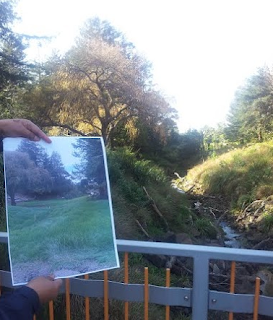On Monday four of the Tamaki College envirogroup leaders +Mano Abraham, +Racheal Kaitu'u, +Bobbigrace vili and +Lana Poila went out to Green Bay to see what the finished product of daylighting a stream looks like.
We met with Konrad Heinemann, Tom Mansell and Josephine Bartley. Konrad and Tom were there to explain the process of daylighting a stream, while Josephine was there to learn like us.
Why was this trip so important? What does a stream in Green Bay have to do with the students and staff of Tamaki College? And why were Auckland Council engineers and project managers eager to take time out of their day to speak to us!?
The reason is that a similar project is now underway at Tamaki College! We have a pipe just like the one in the picture above running under our rugby fields, from under the library out to the reserve past the Rec.
However, with all the development and new building happening in Glen Innes, Auckland Council has decided now is a good time to remove the stream from it's concrete prison and return it to a more natural state.
There are lots of things that need to be considered; run-off, flow rates, water quality, fish passage, engineering considerations, 10-year flooding events, the stream ecosystem, preschool childrens' access and safety, Tamaki College security and aesthetics, council budgets, community interests...
The picture above shows the final product of the La Rosa daylighted stream; every rock and plant and tree stump was purposely placed. This will eventually be what the Tamaki College stream might look like - with a little less water!
This picture showed the middle stage of construction, revealing the pipe - and what it looks like now.
Together we all went for a walk around the park, following the stream as it meandered through the natural dips that had been slightly enhanced... we walked past this particular section and could see what stream daylighting engineering technology used to look like - some rocks held in place by chicken wire! Auckland Council has refined their technique since then...
This is an outdoor classroom at La Rosa, and Tamaki College is lucky enough to be getting their own outdoor classroom too! Again, different considerations need to be balanced; the cost of building by Auckland Council, the design selection, how much our students can be involved in the construction (e.g. carving, trades, woodwork, earthworks), the cost of maintenance after Council hands over ownership to the school, etc.
The Council were proud of this particular outdoor classroom design at La Rosa because it gets people down to the stream and interacting with the water. Safety does need to be considered, but I guess you can't wrap everyone in cotton wool! I think overall they made the right choice, because there is a bridge to the left that can also be used to cross the stream but apparently all the students and community members walk down the banks and cross the stream using the stones!
At La Rosa the Council also planted an orchard but the community nearby quickly took over to maintain it. Preschool children have painted the signs to label each of the trees, and a worm farm/compost was being run as well to fertilise the plants. The Council was even told to back away from the project because the community had it all under control! Our Tamaki students were most excited by the orchard as well, I think.
This is a 'before' picture held up to the view now. Again, every tree trunk and rock were deliberately placed to create riffles and oxygenate the water, or provide shade or shelter for invertebrates, eels, etc.
This was another picture of the stream now, I think it's such a pretty picture it could even be a wallpaper for my laptop!
We finished our loop around with the stream at a covered sign, which the Auckland Council boys were kind enough to give us a sneak-peak at!
This photo shows the soon-to-be-unveiled signage created by the community about the daylighting project and stream ecosystem. It is made of a repurposed section of the original pipe that the stream was held in! What a cool example of recycling and community engagement - the artwork on the sign came from them as well :)
Each of the envirogroup members came up with ideas that they would like to incorporate into the project - these can be added to all the ideas they got from Green Jam at Macleans College last week!
The next Envirogroup Meeting will be jam-packed with ideas and discussion :)
Feel free to come along and join us on Thursdays at lunchtime in the Whare Kai - pizza occasionally provided :P

















